Laundry stripping is a cleaning method that promises to remove built-up residue from fabrics, especially those that may appear dingy or discolored despite regular washing. This technique uses a combination of hot water, detergent, and often additional ingredients like baking soda and washing soda to deeply cleanse items such as towels, sheets, and heavily soiled garments. The process involves soaking laundry to draw out the trapped dirt, moisture, and product buildup, leaving items fresh and revitalized. In this article, we will explore the concept of laundry stripping, its effectiveness, and practical tips on how to implement it.
Understanding Laundry Stripping

Laundry stripping is designed to tackle the gunk that can accumulate in textiles over time, primarily due to prolonged exposure to detergent, fabric softeners, and other laundry additives. Items like towels, bed linens, and athletic wear are particularly susceptible to this buildup, causing them to lose their absorbency and freshness. The stripping process usually involves immersing items in a solution of hot water mixed with specific detergents and boosters that help in breaking down and pulling out the residue. Here’s a detailed breakdown of what laundry stripping entails:
- Preparing the Solution: Combine hot water with equal parts of laundry detergent, baking soda, and washing soda.
- Submerging the Laundry: Place fabric items directly into the solution and allow them to soak, typically for several hours.
- Rinsing Thoroughly: After soaking, rinse fabrics well to remove any residue and soaking chemicals.
This method can give new life to fabrics that seem beyond rejuvenation, but it’s essential to weigh its benefits against possible risks, such as fabric degradation or color bleeding in some items.
Does Laundry Stripping Actually Work?

Proponents of laundry stripping often rave about its efficacy, citing dramatic improvements in the cleanliness and freshness of their laundry. However, the question remains: does it really work? The short answer is yes; many users report positive results. The scientific principles behind stripping suggest that the hot water and additional ingredients effectively break down the residues and oils that regular washing can leave behind, especially in high-performance fabrics. Here are some noteworthy points regarding its effectiveness:
- It can significantly restore absorbency to towels.
- Fabrics may smell fresher and feel cleaner after treatment.
- It is particularly useful for items that have been washed repeatedly without using a loan detergent.
However, it’s important to note that results may vary based on fabric type and the level of buildup present. While laundry stripping can work wonders for some, it may not be suitable for all textiles and should be approached carefully.
Best Practices for Laundry Stripping

To maximize the effectiveness of laundry stripping and protect your fabrics, consider the following best practices:
- Check Fabric Care Labels: Always read care labels before stripping to avoid damaging delicate fabrics.
- Limit to Specific Items: Focus on items that genuinely need it, like towels and sheets, rather than frequently laundered clothing.
- Use the Right Ingredients: Make sure to use a detergent without added fragrances or softeners, as these can counteract the stripping process.
- Monitor Time: Do not exceed the recommended soaking time; excessive soaking can lead to fabric wear.
By following these practices, you can achieve optimal results while minimizing the risk of damage to your laundry. Adapting these methods with caution allows for a successful laundry stripping experience.
Potential Risks and Considerations
While laundry stripping can be incredibly effective, there are potential risks and considerations one should keep in mind before diving into the process. Some fabrics, especially those labeled as dry clean only or with specific finishes, may not withstand the stripping technique very well. Furthermore, color bleeding can occur, particularly with vibrant or dark fabrics. Here are some key considerations:
- Colorfastness: Always test a small area if you’re unsure about color stability.
- Fabric Type: Avoid stripping delicate fabrics like silk, wool, or those with embellishments.
- Odor Concerns: Be aware of the potential strong odors from baking soda and detergent mixtures.
By remaining vigilant about the materials being treated, you can successfully maximize the benefits of laundry stripping while minimizing risks.
Conclusion
In summary, laundry stripping serves as a powerful method for reviving your fabrics and overcoming stubborn residue that standard washing may leave behind. While it has proven effective for many, ensuring you follow best practices and consider potential risks is crucial to the process’s success. If you’re ready to experience fresher laundry and enhanced fabric performance, give laundry stripping a try while maintaining caution to preserve your beloved items.
FAQ
1. Is laundry stripping safe for all fabrics?
No, laundry stripping is not safe for all fabrics. Delicate materials, like silk or wool, should be avoided as they can be damaged during the process.
2. How often should I perform laundry stripping?
It depends on the frequency of use and the buildup of detergent or residues. Generally, it’s recommended to strip laundry every few months, especially for towels and bedding.
3. Can I use laundry stripping on colored items?
It is possible to strip colored items, but color bleeding can occur. Testing a small, inconspicuous area first is advisable to ensure colorfastness.
4. What ingredients are best for laundry stripping?
The most commonly used ingredients include hot water, regular laundry detergent, baking soda, and washing soda for effective cleaning.
5. Can laundry stripping help with odors?
Yes, laundry stripping can help remove odors trapped in fabrics by breaking down the residues that cause unpleasant smells.
